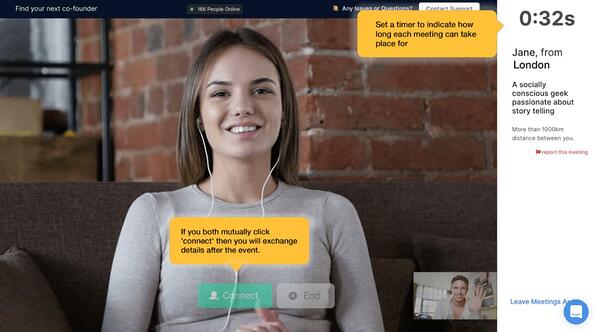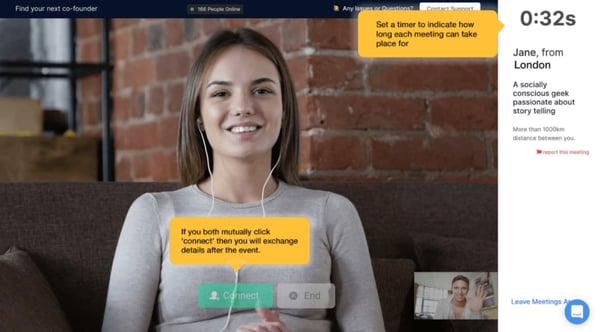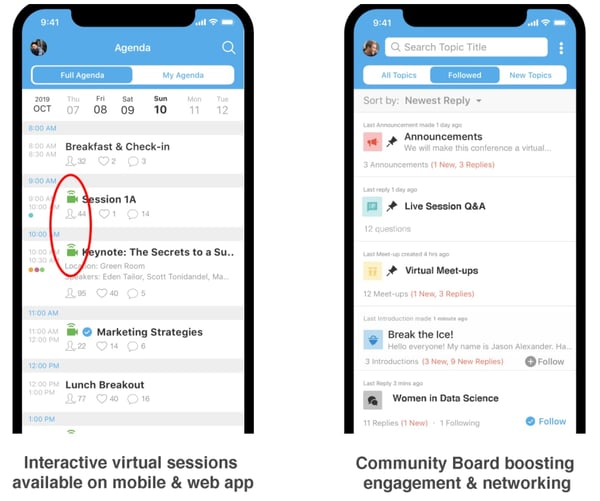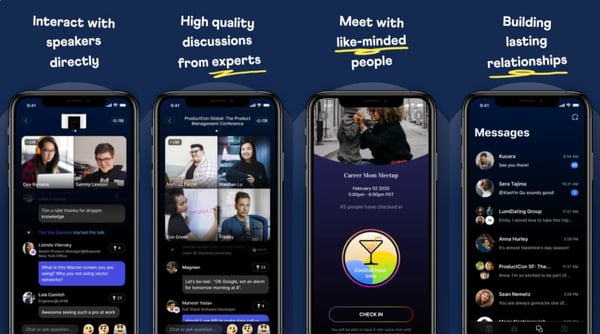How to Run a Successful Virtual Event [+ Examples]

Nowadays, plenty of business is done virtually.
For instance, you might begin your morning by answering emails and editing a colleague’s blog post via Google Doc. Your colleague is working from home today, so you Slack him to let him know when the piece is ready.
In the afternoon, you have a 1:1 via Zoom with your remote manager.
Then, around 4 PM, you log into a company’s webinar to learn more about Social Media Marketing in 2020. The webinar has a panel of experts, and you’re able to download the recorded webinar later for future reference.
Undoubtedly, online tools and experiences are an integral part of a modern marketer’s role.
However, there is one aspect of business that seems, until recently, almost entirely untouched by virtual experience: conferences.
Our historic mindset around conferences is that we board a plane to a conference, bring our business cards, and prepare ourselves for a week of keynote speakers, breakout sessions, and networking events that enable us to spread the word about our own products and services, while collaborating with other marketers who might have useful tools or suggestions of their own.
In 2020, there will likely be a rise of virtual conferences. Here, let’s explore the benefits of virtual conferences, take a look at some examples of successful virtual conferences to inspire you, and check out a few tools that can help you plan your own.
But first — let’s talk about why virtual conferences can benefit your business in the future.
Virtual Conference Benefits
There are plenty of major benefits to hosting a virtual conference.
For one, it can lower the price of admission, enabling smaller businesses with limited budgets to purchase tickets to your conference and offer their own unique insights.
It also lowers the cost your business would have to pay for conference space, on-hand staff, catering, security, and much more.
Additionally, it allows people from across the globe to interact with each other without needing to spend exorbitant amounts on flights and hotels. Imagine how much easier it is for marketers from India, Ireland, Australia, and the U.S. to collaborate virtually, rather than trying to gather in-person.
It also may help you attract high-demand speakers who don’t have the time to commit to an in-person conference, but are happy to share industry takeaways via a quick video call or pre-recorded presentation.
Additionally, an online conference enables you to create a product — recordings from your conference — that you can continue to share and use as a lead generation tool for months and years after the initial live launch.
And, finally, there’s the obvious: sometimes unforeseen circumstances can make in-person conferences in certain locations simply impossible.
Emily Raleigh, HubSpot’s Marketing Manager of Brand and Strategic Partnerships, provides some advice if you suddenly find yourself shifting your in-person event to a virtual one: “If you are shifting from a live event, try to add extra value to the viewers who are now tuning in online. Do an extra session. Offer more Q&A time. Give an extra special offer. Find creative ways to add extra delight moments.”
Additionally, Raleigh mentions, “Virtual events can easily lose one of the best benefits of live events: human connection. To mitigate that, keep the event engaging and get the audience involved.”
Now that we’ve explored a few benefits, let’s dive into tools that can help you create your own virtual conference.
Virtual Conferencing Tools
1. Hopin
Hopin is an all-in-one platform for planning online conferences, offering everything from a virtual reception to breakout sessions, a mainstage, and networking events.
The networking tool is particularly helpful, with a timer you can set for each attendee to mingle with another for just a couple minutes before moving onto the next conversation (and, if the conversation goes exceptionally well, they can click “Connect” to receive contact information of the other attendee to follow-up later).
Your event can include both webinars and live-streams, and a Live Chat function enables attendees to ask questions in real-time. Additionally, attendees can use virtual booths to promote their products or services, and offer discounts as well.

2. Whova
The Whova Event App has been a leader in attendee engagement and networking since 2014. For four years in a row, Whova has received both the Best Event App award and the People’s Choice Award from the Event Technology Awards.
Event organizers can use Whova to help make online events highly interactive, fun, and productive before, during, and after the event. The tool directly integrates with live streaming and video hosting tools such as Zoom, Google Hangout, YouTube, Vimeo, etc. It also provides live Q&A, attendee networking, a discussion board, meeting-matches, a virtual exhibitor hall, and even virtual meet-ups.
Many organizers provide access to the Whova app prior to their events to let attendees virtually socialize and discuss various topics, one-on-one or in virtual groups, making everyone feel more connected by the time the event comes around. Every attendee has a professional profile, allowing them to find others with whom they have common interests. The ice breaker and in-app chat, in particular, make it fun for strangers to get to know one another on a personal level and communicate with both new and old friends.

3. Run The World
Run The World is an all-in-one online conference platform with tools for livestream talks, discussions, and panels — additionally, Run The World ensures the social aspect of your virtual event is not lost, with a virtual “cocktail party” option, and an algorithm that matches attendees with other like-minded individuals based on questionnaires they fill out prior to the event.
Run The World is accessible to a variety of small and large organizations, including non-profits, startup and enterprise businesses, and individual experts who’d like to host online workshops or bootcamps.

Alternatively, if you don’t have the budget for a virtual conferencing tool or simply don’t need much more than a simple video and mic, you might consider video call tools like Zoom, Google Hangouts, or ezTalks.
Examples of Virtual Conferences
1. Game Developers Conference
The 2020 Game Developers Conference (GDC) switched its in-person conferences to streaming recorded versions on the GDC Twitch channel. The conference will still have ceremonies for The Independent Games Festival (IGF) and Game Developers Choice Awards (GDCA), and will stream session content starting 9 AM PT daily, March 16-20.
The GDC has a well-organized itinerary posted on their website, with breakout sessions led by influencers and experts in the Gaming industry.
Additionally, you’re able to pause Live sessions if you’re interested in watching at a later time, and the GDC has included “Recommended Channels” with headcounts on the left side of the screen. With some sessions evoking over 30,000 viewers, it’s safe to say the GDC has successfully launched a virtual version of their initially in-person event.
2. HubSpot’s Partner Day
On April 7-8, 2020, HubSpot launched its own virtual Partner Day. The Partner team used Zoom, a popular video conferencing tool, and sent each presenter a “video kit” with a mic, camera, lighting, and backdrop, so that participants could experience an optimal viewing experience from each of the day’s virtual speakers. Additionally, attendees used Zoom to network with other partners.
I spoke with Arden Brust, a Manager on HubSpot’s Partner Marketing team, to learn about some challenges you might experience when planning a virtual experience of your own.
Brust told me: “When planning an online event, it’s critical you remain flexible and open-minded. With a virtual event, you run the risk of technology issues, as well as scheduling issues you might not have considered if you had everyone in-person (including timezone issues). To combat this, continue to iterate with your team and plan on pivoting — don’t get too attached to plan A that you don’t consider how plan B might work out better.”
3. How I Built This, by Women In Product
With the help of the Run The World virtual conferencing tool, the non-profit organization Women In Product launched an entirely virtual event March 7-8, 2020. The Women In Product conference included participants from China, India, Canada, and Silicon Valley.
The conference featured 10 speakers who’ve built successful products — including the Director of Product at GoDaddy, a PayPal Product Lead, and a Senior Product Manager at Ebay. The virtual event included fireside chats, keynote speakers, and networking events that enabled women to hear about the challenges and successes of product launches in different markets.
4. Webinar Mastery Summit
Jon Schumacher had hosted webinars online for a while with minimal results when he launched the Webinar Mastery Summit, a virtual conference for people who wanted to advance their webinar skills.
His first virtual summit featured 25 experts, and generated 7,000 new email subscribers and over $55,000 in revenue with his All-Access Pass sales. With All-Access, his participants receive lifetime access to 17 expert video sessions, full MP3 recordings of all sessions, three months of course creation software, and access to a private community for additional networking.
Ultimately, with virtual conferences, you’re able to create recorded packaged content for future lead generation and sales even after the initial live launch — something in-person conferences, for all its networking benefits, is unable to do.
5. HubSpot User Groups (HUGs)
Meghann Keogh, a HubSpot Marketing Manager in charge of HubSpot User Groups and Events, has experienced circumstances in which she found it necessary to cancel in-person events and create virtual ones, instead. Keogh told me she’s hosted virtual HUGs events for San Francisco, NYC, Berlin, London, Helsinki, Paris, Bogota & Mexico City.
Additionally, she’s created virtual fireside chats, including an upcoming one with CEO & Co-Founder Brian Halligan & Christian Kinnear, VP of Sales & Managing Director EMEA.
When asked how to run a successful virtual event, Keogh told me — “Whether in-person or virtually, people are hungry to connect. The feedback we have received so far has been extremely positive. It’s not just cities that are connecting, it’s countries.”
“What’s made our virtual events a success so far? Our amazing speakers who inspire, educate, and innovate our HUG communities.”
Keogh adds, “We’re committed to bringing relevant content to our HUGs, whether that’s in-person or virtually. We want to make sure our communities still have that chance to engage with one another, and we’re devoted to making that happen.”
![]()
Nowadays, plenty of business is done virtually.



